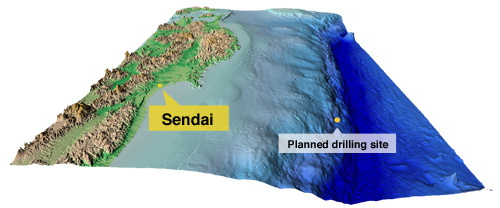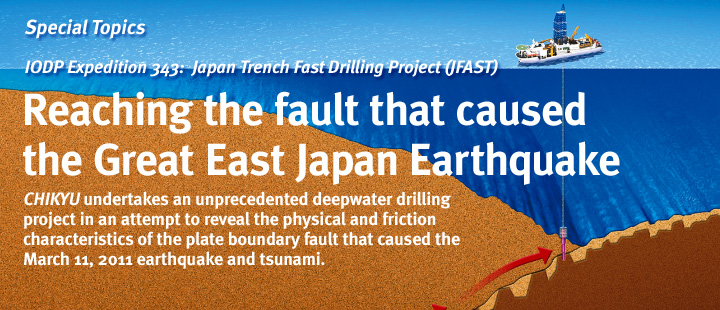
 |
Frederick M. Chester Professor Dept. of Geology and Geophysics Texas A&M University |
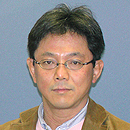 |
Ryota Hino Associate professor Research Center for Prediction of Earthquakes and Volcanic Eruptions, Graduate School of Science, Tohoku University |
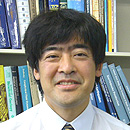 |
James J. Mori Professor Disaster Prevention Research Institute Kyoto University |
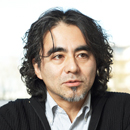 |
Nobuhisa Eguchi Group Leader IODP Promotion Group Center for Deep Earth Exploration JAMSTEC |
CHIKYU will begin a new drilling research project in April. The clues to understanding the mechanisms of the huge earthquake and tsunami that devastated East Japan in March last year, are to be found under the ocean floor near the Japan Trench. It is hoped that the results of this study will
improve our knowledge and understanding of major earthquakes around the world. The project involves enormous challenges: CHIKYU will drill in an ocean depth of 7,000m, to reach the fault that lies some 1,000m below the seafloor.
(Published in April 2012)
An urgent drilling study
The 2011 earthquake off the Pacific coast of Tohoku was a magnitude 9.0 event, significantly larger than any eathquake anticipated for the Tohoku region and larger than any earthquake that has been recorded in over 500 years of history in Japan. The huge tsunami that followed resulted in tremendous damage and loss of life. The disaster had a huge impact, not only on seismologists but on all Japanese. The earthquake itself was an interplate earthquake that occurred between the oceanic and continental plates of the Japan subduction zone. Subsequent research has determined that major geomorphic changes took place over a wide area of the seafloor, from close to the epicenter off the coast of Miyagi Prefecture to the Japan Trench (see sidebar)
For the planning of the Japan Trench Fast Drilling Project (JFAST), Integrated Ocean Drilling Project (IODP) required a particularly rapid process of review of the scientific proposal. Because of the urgent nature of the work, the project has moved from scientific proposal to implementation in an unusually short period of time. Research on the mechanisms behind huge earthquakes is an important aspect of the mission of IODP, and it was agreed that a detailed study of the movement of the fault during the earthquake should be carried out as soon as possible.
The expedition is scheduled to take place over 54 days from April 1 to May 24. Drilling will be done to a depth of about 1,000m below the seafloor in an area where there was very large fault movement during the earthquake was at its most pronounced. Drilling will take place at a water depth of
about 7,000m. The location lies close to the axis of the Japan Trench, about 250km east of Sendai city, which is the largest city in the Tohoku region. There has never before been a borehole over a few tens of meters in such deep water. (A borehole to 15 m depth was drilled in 7,034m water depth
in the Marianas)

